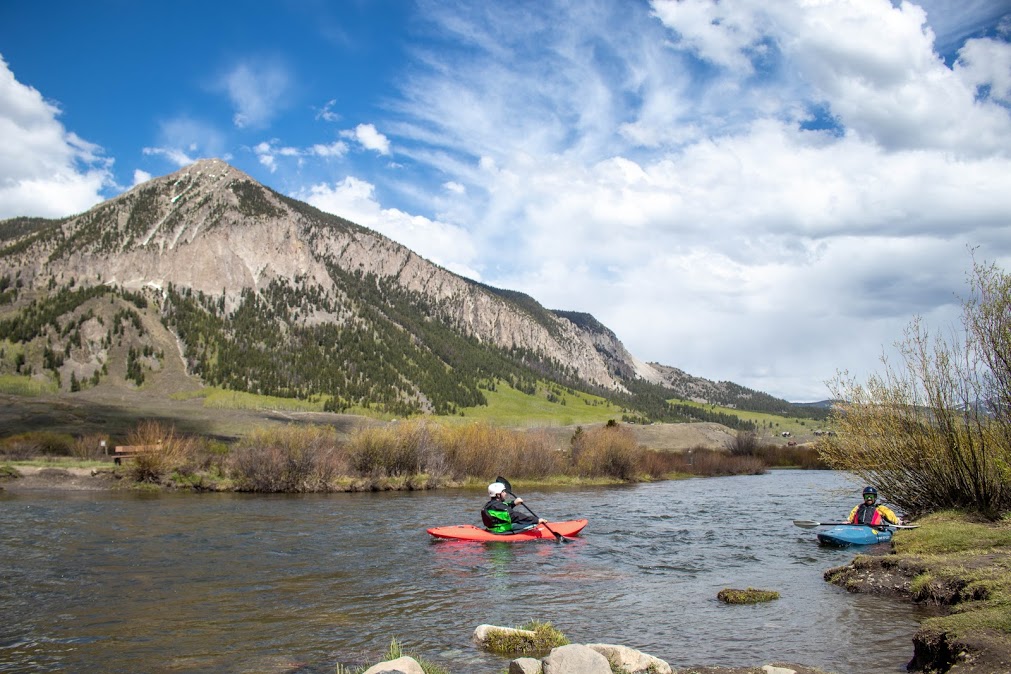When I think about landscape connectivity, my mind’s eye turns to what disconnected landscapes would look like. The wide-open valleys, prairies and farmlands that define Colorado today are missing. Wildlife are homeless or injured; rivers and lakes have limited waterflow. And Coloradans are wondering: Could more planning and thought have gone into protecting these landscapes and our way of life?
As dystopian as these images may seem, they bring to mind the important idea that Colorado’s lands and waters are necessarily connected. They work together. But they are at risk of being disconnected – some say disappearing – if we don’t protect them from threats such as climate change and population growth. In addition to endangering the natural resources Coloradans depend on, these threats make it financially harder for rural families to stay on working lands, and harm communities that rely on thriving agriculture, recreation and tourism economies.
There are many interests to balance. And a few different conservation plans are currently in the works. But ultimately (and thankfully) the goals overlap. At Keep It Colorado, our planning centers on conserving private lands. Coordinating – connecting – with other groups working toward similar goals will help all these plans succeed.
Filling a gap for a connected future
“Land conservation” often conjures up images of public lands in national and state parks, forested areas, wildlife refuges and wilderness areas. But private lands account for a huge portion of the state that needs protection: nearly 60 percent of Colorado’s land is privately owned. Communities count on land trusts to protect these natural resources for the long term and benefit all of us.

The Alamosa River running through the Cactus Hill Ranch. The river corridor has experienced significant environmental impacts from the Summitville Mine upstream (now a Superfund site). Rio Grande Headwaters Land Trust will work with landowners and partners in spring 2021 to restore portions of the river corridor to further the EPA’s extensive reclamation efforts. Photo: Rio Grande Headwaters Land Trust
Since 1965, nonprofit land trusts have helped conserve over 3.2 million acres, permanently keeping working farms and ranches in production; restoring critical wildlife habitat; and protecting open space and Colorado’s iconic vistas. In addition to making agreements with landowners to voluntarily conserve their properties, many land trusts have expanded their portfolios – from involving local communities in setting conservation priorities to grooming the next generation of land stewards.
As a statewide coalition, we support our members in this work. We bring them together to explore conservation challenges and opportunities and to problem-solve. One gap we’ve observed is the lack of a unified, coordinated statewide plan that prioritizes the protection and connectivity of private lands.
To fill that gap we’re developing the Statewide Private Lands Conservation Plan (with generous funding from Great Outdoors Colorado and the Colorado Water Conservation Board). The plan will identify concrete private lands conservation goals, identify urgent areas for protection and create a roadmap of on-the-ground projects. And it will set common conservation values that reflect the economic, ecological and social needs of local communities.
Meanwhile, calls to meet 30×30 – a goal to conserve 30 percent of lands and waters by 2030 – are growing. And many of our partners are creating or updating statewide plans around water, wildlife and recreation. For example, the Colorado Water Conservation Board is updating the Colorado Water Plan. Colorado Parks and Wildlife is identifying wildlife protection priorities and recreation opportunities to develop a comprehensive statewide recreation and conservation plan.
There are many converging interests at play, and our intention is that our plan will advise and support all of these broader initiatives – contributing a valuable piece to the whole conservation puzzle.
Broad goals, unified vision
Our goals are wide-ranging, but they all point to the vision of a more sustainable future. The plan will unify the work of Colorado’s land trusts with a call to action to conserve and connect critical wildlife habitats, working landscapes at risk of being converted or developed, and vital waterways. Through partnerships, we’ll be able to understand local community needs and balance those with larger statewide objectives.

A restored spring at Raven’s Nest Nature Preserve on Colorado’s southeastern prairie, managed by Southern Plains Land Trust. With its short-grass prairie, seasonal creeks and gullies, and sandstone outcroppings, the preserve provides critical habitat for a variety of herptiles, birds, mammals, invertebrates and native plants. Photo: Linda Lidov
As an example, consider the Arkansas Basin, a diverse region ecologically, economically and culturally. In the southeastern part of the basin, the shortgrass prairies are essential wildlife corridors and are among the country’s most endangered habitat. Here, development pressure is low compared to the upper basin, where people flock to build homes and commercial infrastructure, and where tourism and outdoor recreation are central economic drivers. Region-wide, there’s an urgency to preserve a critical mass of irrigated farmland and to address water scarcity. Land trusts are exploring ways to collaborate and tackle these challenges, which are common and unique at the same time; their regional work will serve as a blueprint for our statewide plan.
Our plan will also map vital landscapes that need to be protected from the effects of climate change. We know that conservation alone can’t end climate threats, but it plays a role in mitigating the impacts. Using scientific data and The Nature Conservancy’s Resilient and Connected Networks tool, the plan will identify the landscapes and the number of acres to conserve over the next 10 years. It will look at type and quality of habitat to be conserved. And it will outline the use of natural climate solutions, including land protection and management strategies to, for instance, avoid conversion of forests, wetlands and grasslands to other uses; improve soil health; maintain natural working lands; and mitigate flood and fire risks.
Finally, our plan will help increase community-driven conservation. We define this as conservation that communities engage in, initiate or support – from Indigenous peoples with ancestral ties to these lands and multi-generation farming and ranching families, to newcomers and people who have grown up playing in Colorado’s natural landscapes.
In a brighter picture of the future, Colorado’s land and water landscapes are connected, and the wildlife and people that rely on them have plentiful and sustainable food to eat, water to drink and a way of life that’s connected to nature. Communities are resilient and can adapt to change.
We look forward to working with our partners to coordinate conservation strategies and make connectivity happen. Because if our collective efforts are fragmented, the results will be, too.
Learn more about water and land trusts in our most recent issue of Headwaters: Forever Entrusted.
 Linda Lidov is director of membership and communications for Keep It Colorado, a nonprofit coalition of conservation organizations. Since 2010 Linda has been writing and storytelling about conservation topics – from outdoor volunteer stewardship and youth conservation corps programs to state-led energy efficiency programs and the U.S. EPA’s Brownfields initiative. She also spent 11 years leading communications efforts about the use of satellite imaging technologies for a variety of applications including natural resources monitoring and management.
Linda Lidov is director of membership and communications for Keep It Colorado, a nonprofit coalition of conservation organizations. Since 2010 Linda has been writing and storytelling about conservation topics – from outdoor volunteer stewardship and youth conservation corps programs to state-led energy efficiency programs and the U.S. EPA’s Brownfields initiative. She also spent 11 years leading communications efforts about the use of satellite imaging technologies for a variety of applications including natural resources monitoring and management.


 Print
Print